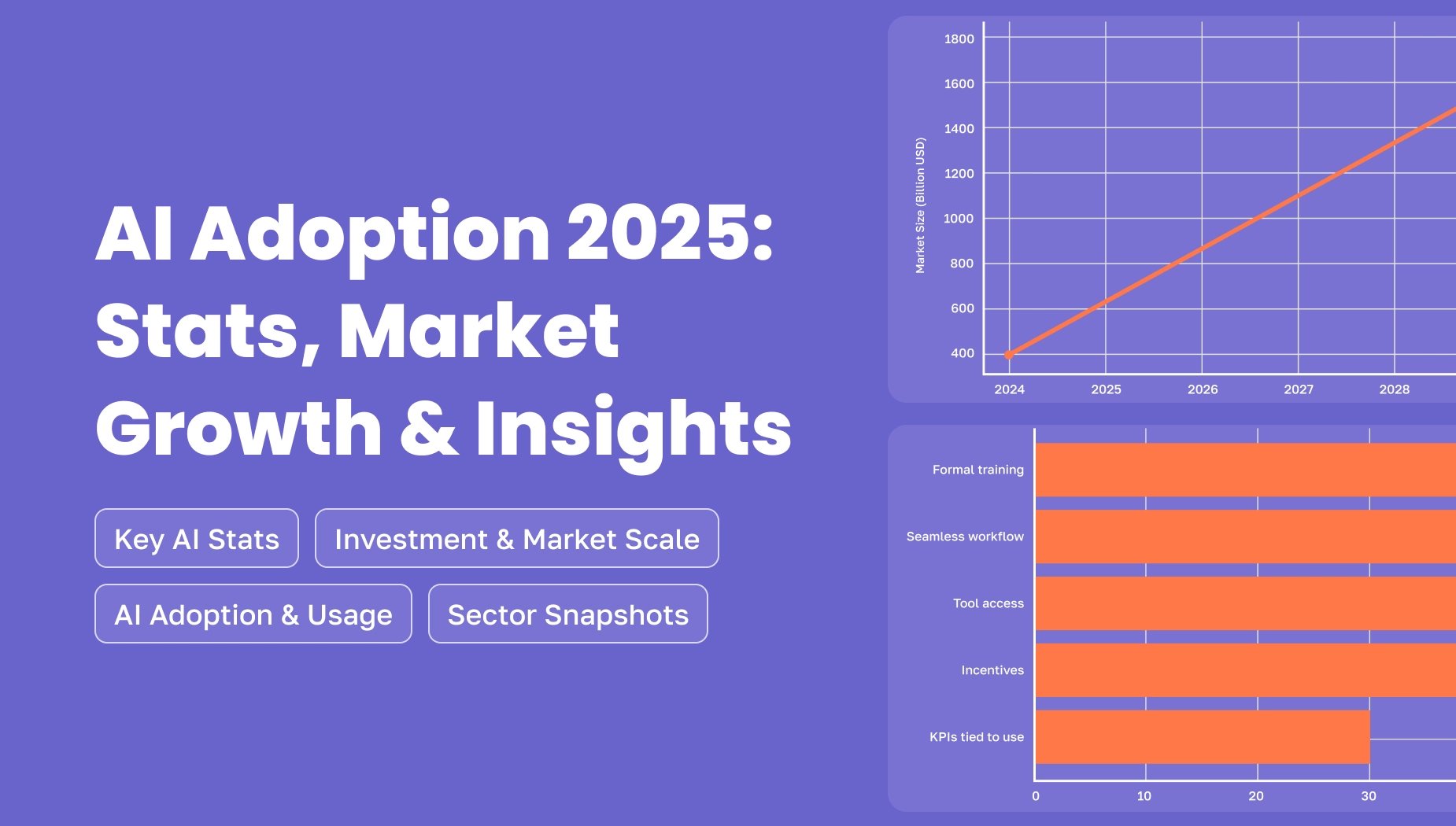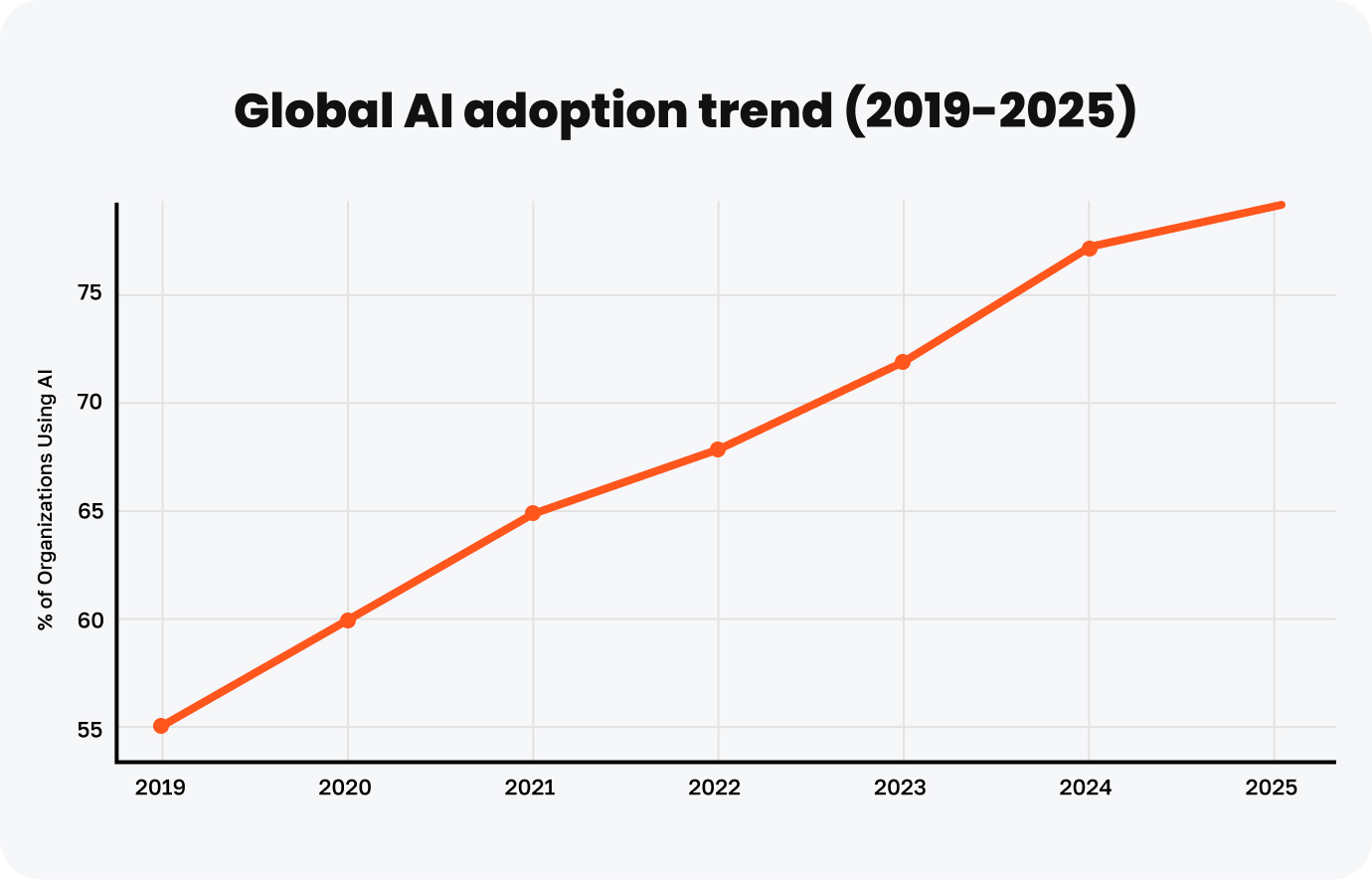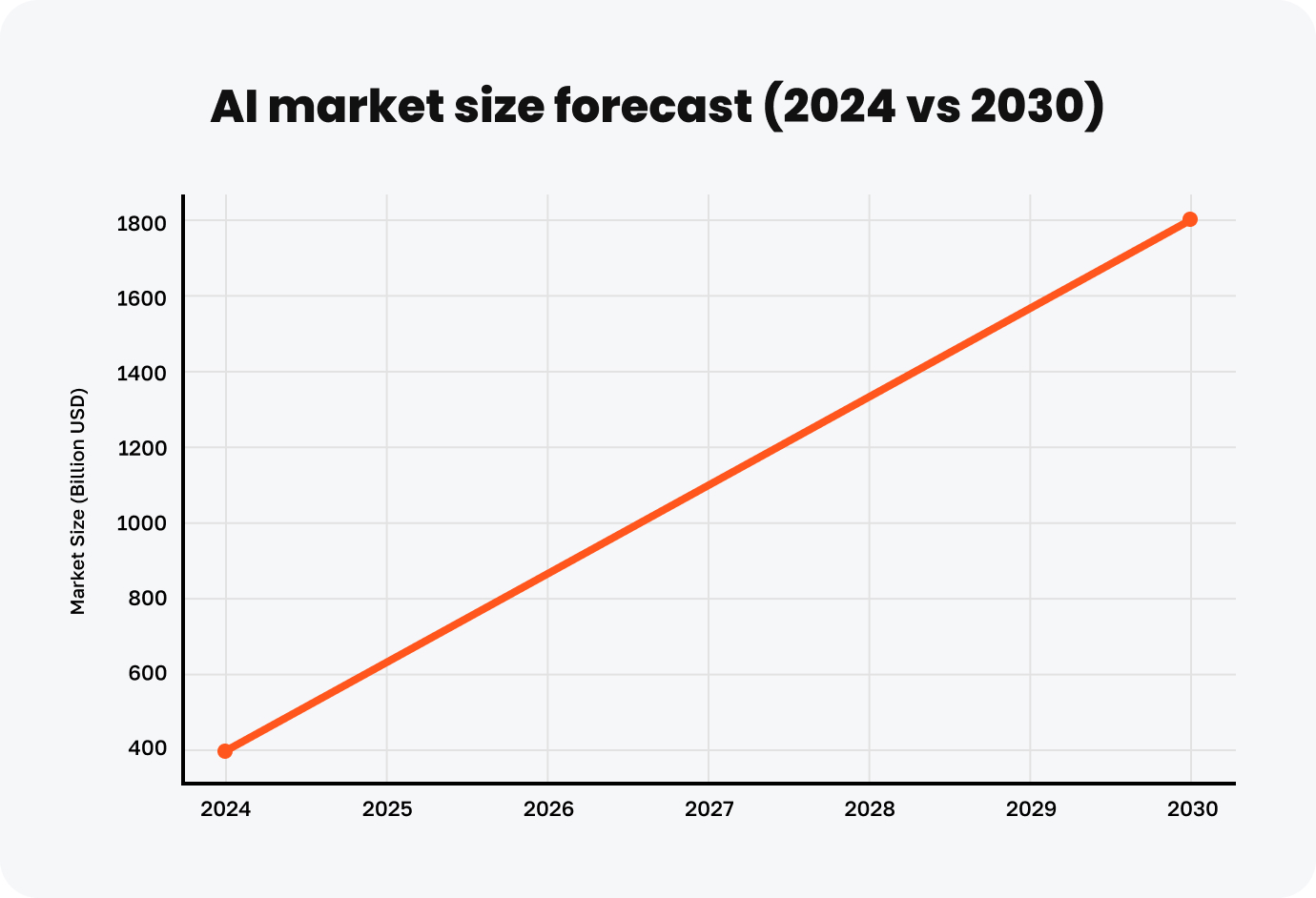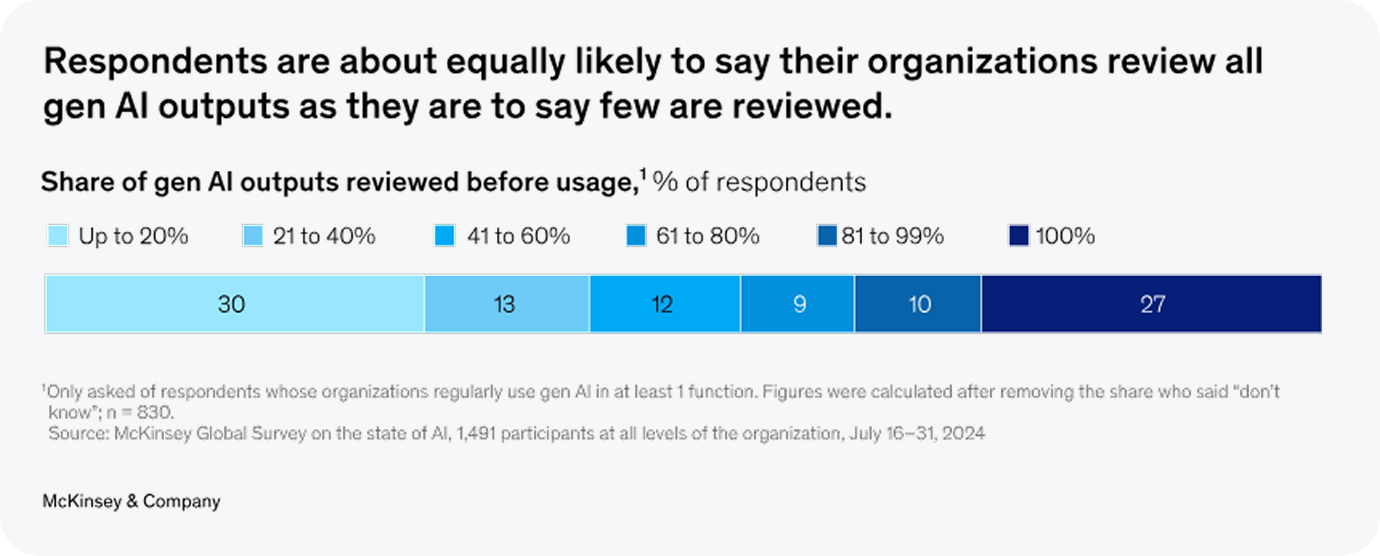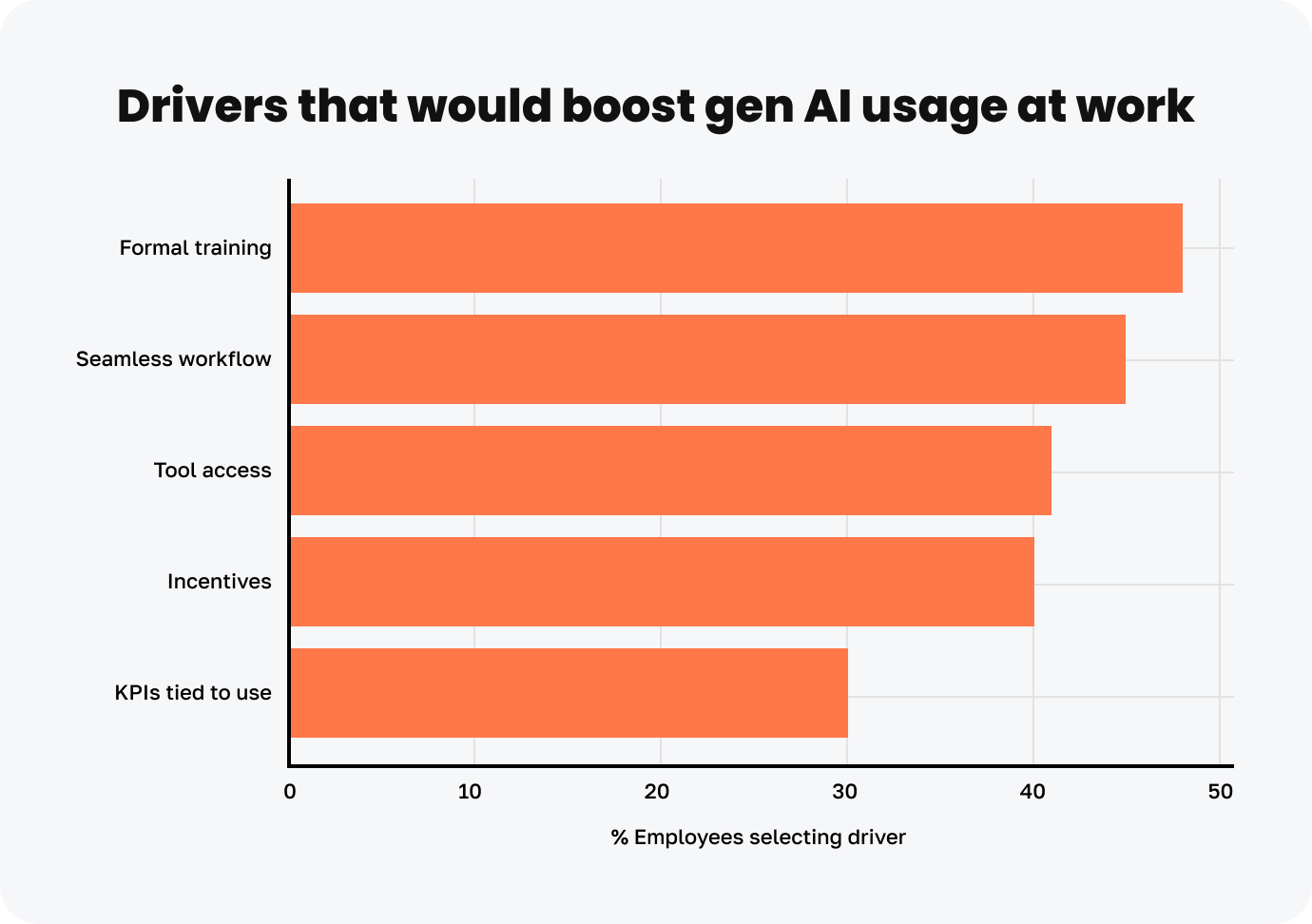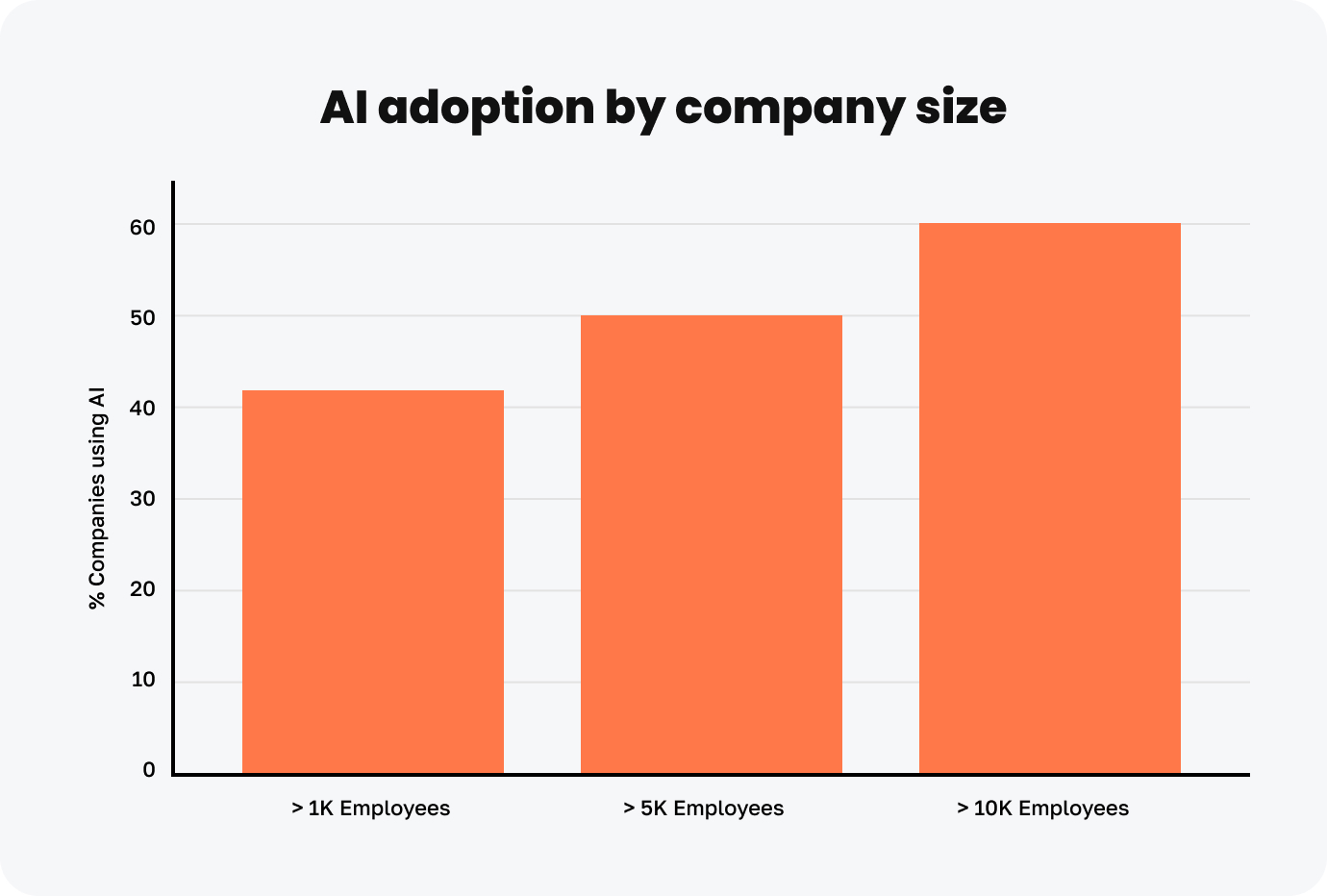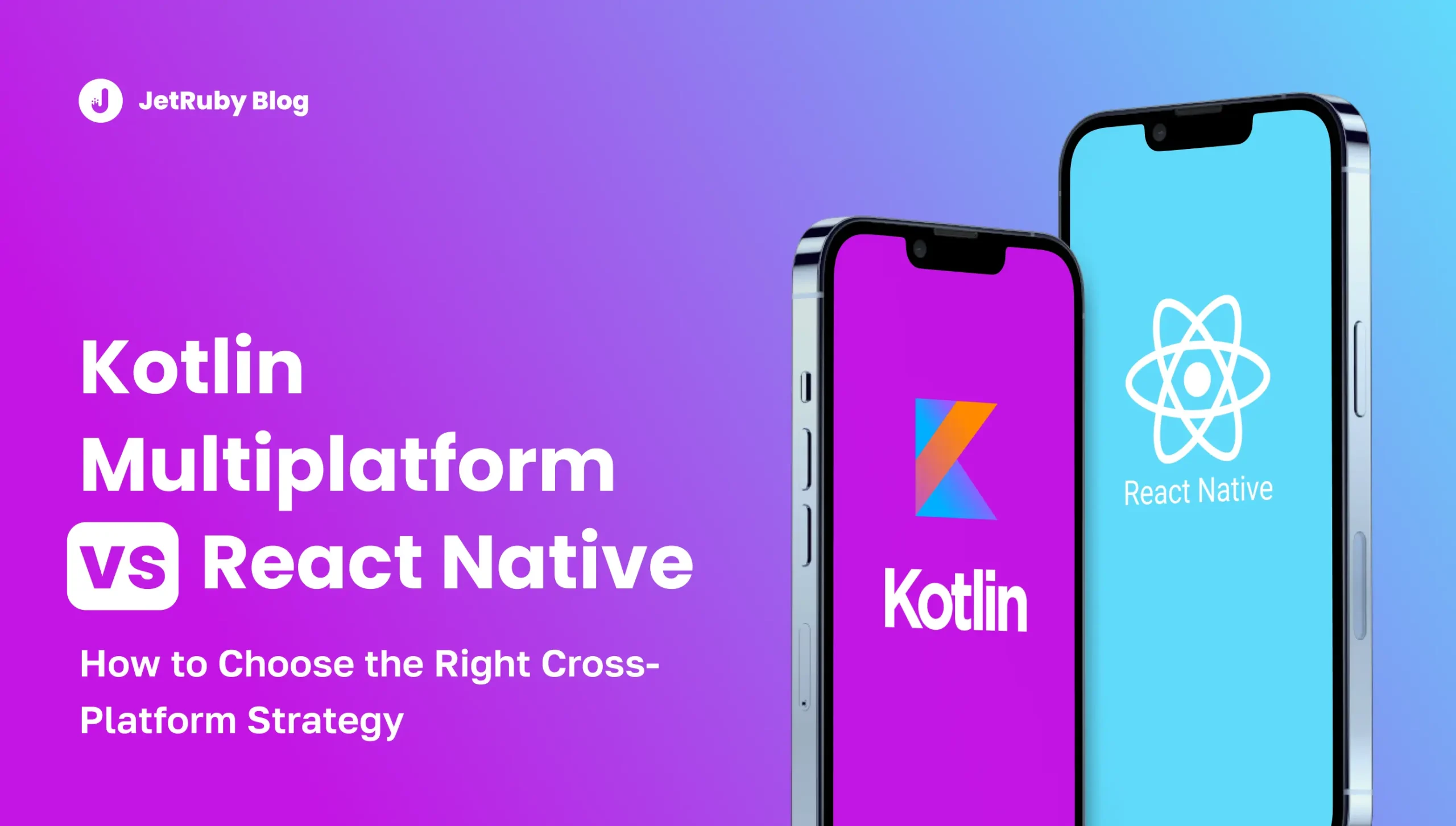Table of Contents
The year 2025 marks a pivotal moment in the business world as Artificial Intelligence moves from the realm of potential to widespread implementation.
In this article, we delve into the current state of AI adoption, revealing the impressive surge in its integration across industries. We gathered hard numbers from Microsoft, McKinsey, Forbes, and Exploding Topics to map clear lessons for CEOs, CTOs, and business leaders.
Key AI Stats
- 78% of organizations use AI in at least one function (2024).
- 71% of companies use generative AI in at least one function.
- 83% of companies claim AI is a top priority.
- 92% of companies plan to raise AI budgets over the next 3 years.
- Only 1% of leaders call their organizations “AI mature”.
- Global AI market: ~$391 B today, set to reach ~$1.8 T by 2030
- 48% of employees consider AI training essential, yet ~50% feel under-supported.
- Millennials are 1.4× more likely to use AI than other age groups
AI Adoption and Usage: Large Companies Leading the Charge
The integration of Artificial Intelligence into business operations has experienced a notable surge in recent years.
In 2024, 78% of organizations reported using AI in at least one business function, up sharply from 55% a year earlier. Generative AI tools are spreading quickly — 71% of firms now use gen AI in one or more functions.
Most businesses treat AI as strategic: roughly 83% say AI is a top priority. In short, AI has moved beyond pilots to become core to business planning.
Enterprises are leading the charge, but smaller firms aren’t far behind. High-revenue companies (>$500M in sales) adopt AI faster than mid-sized ones. Executives at large firms report more AI projects and dedicated teams.
In contrast, many mid-market companies have only limited proof-of-concept or pilot programs. Even so, growing numbers of small businesses and startups are embedding AI from day one. Overall, AI use is gaining ground across sectors and company sizes.
Investment and Market Scale: Big Bets on AI
McKinsey finds that 92% of companies plan to increase their AI investment over the next three years. Tech industry giants alone will spend $371 billion on data centers and computing resources by 2025 (e.g., Amazon, Microsoft, Alphabet, Meta).
Worldwide, the AI market has swelled to roughly $391 billion in 2024 and is projected to exceed $1.8 trillion by 2030. Growth remains blistering: the market is expanding at ~37% CAGR.
Despite heavy spending, few executives feel fully mature on AI. Only 1% of leaders say their company is “mature” in AI deployment.
Most projects remain in early stages. The big opportunity looms: McKinsey estimates a $4.4 trillion productivity boost from AI in the coming years, but capturing that value requires scaling pilots into production.
Enterprise AI Maturity and ROI
Large enterprises report high returns from AI. In surveys, most leaders investing in AI (over 90%) report positive ROI.
However, many still struggle to move beyond pilot projects. McKinsey’s analysis shows less than one-third of firms follow best practices like tracking KPIs or establishing AI governance teams.
Larger companies are twice as likely as smaller ones to use clear roadmaps and dedicated AI teams. This means enterprises often build and scale faster, while smaller companies lag.
ROI is strong when AI is deployed at scale. For example, Netflix earns ~$1 billion annually from AI-driven recommendations. About 97% of firms that heavily invest in AI report seeing gains.
Leaders should note that converting AI experiments into value demands investment in people and processes as much as technology.
Workforce Readiness and Skills Shift
The human side of AI adoption is shifting fast. Employees are eager to use AI tools. One McKinsey study found that three times as many workers use generative AI for a third or more of their tasks than leaders realize.
Over 70% of employees believe AI will transform 30% or more of their work within two years. By contrast, executives often underestimate workforce readiness. This gap means workers may drive change faster than expected.
However, skill and training gaps remain a top concern. Nearly 48% of employees say training is the most important factor for AI adoption, yet about half feel only “moderately” or less supported.
To close this gap, companies must invest in upskilling. Younger workers lead the charge: Millennials are 1.4× more likely than other age groups to know gen AI tools and expect near-term workflow changes.
In practice, organizations are hiring for new AI roles. The McKinsey State of AI survey shows firms are adding data scientists, ML engineers, and AI governance specialists.
For example, 13% of companies have hired AI compliance experts in the past year. Overall, more than half of U.S. employees using AI report management actively encouraging its use, underscoring the top-down push.
Sector Snapshots: Enterprises, Mid-Sized, Startups
AI adoption depends on the company level, too. Let’s look at the difference.
Enterprises
Large corporations lead in formal AI programs. As noted, nearly 80% use AI in some functions. Many have designated AI governance (sometimes CEO-led) and centralized Centers of Excellence.
These companies focus AI on IT, marketing, sales, and operations. The largest see the most applications: companies above $500M revenue deploy AI “throughout more of their organizations” than smaller peers.
Yet enterprises often move cautiously. In McKinsey’s U.S. CxO survey, 47% of C-level executives said their firms were developing AI tools “too slowly,” even though 69% had started investing over a year ago. That frustration drives urgency: 92% plan to boost AI investment.
Mid-Size businesses
Mid-market firms are catching up. Many began AI initiatives only recently, but surveys show strong interest.
For example, about 33% of companies have implemented limited AI use cases (e.g., automating specific tasks). Another 21% have promising pilots, while 25% have one or more fully AI-enabled processes.
These firms tend to use AI for efficiency (chatbots, CRM analytics, manufacturing sensors). Key barriers are budget and talent: smaller teams must often share data-science roles across projects.
Executives here should note that employees often lead adoption: empowering staff with tools can jumpstart progress faster than waiting for a centralized strategy.
Startups and innovation
Many startups are AI-native. Generative AI, in particular, fuels new product models (e.g., content automation, healthcare diagnostics, FinTech). We see rapid venture funding into AI-first companies.
Even hardware and telecom startups spin up AI services — one Gartner report found 52% of telecom firms now use chatbots for customer support.
Across industries, roughly 9 out of 10 organizations expect AI to give them a competitive edge.
That sentiment drives startups to build on AI as a core differentiator. For startup leaders, the mandate is clear: leverage open-source AI (nearly 50% of adopters do so) to accelerate development, while also planning for compliance and ethics up front.
AI-Enhanced Efficiency Transform your business! With AI as a powerful support tool, our skilled engineers work more efficiently and effectively, enhancing outcomes and driving profitability!
Strategic Imperatives for Leaders
The data points to several clear priorities for executives.
Governance and oversight
Assign senior sponsorship of AI programs. McKinsey finds that when CEOs or boards own AI governance, organizations capture more value.
Establish clear metrics (KPIs) and roadmaps. One survey shows nearly 50% of tech leaders regard AI as fully integrated in strategy, but only ~30% see it embedded in everyday operations. Closing this gap requires formal planning and accountability.
Talent and training
Scale up skills fast. Companies with dedicated AI training see quicker adoption. Given that millennials and Gen Z are already AI-proficient, older workforce segments may need extra support.
When trained properly and in time, employees shouldn’t fear of AI taking jobs.
About half of employees feel they lack adequate training and remedying this with workshops or vendor programs is crucial. Also, hire or partner for scarce roles (data engineers, ML engineers, ethics officers) to accelerate progress.
Speed and agility
Move fast but safely. Data shows most employees trust their company to deploy AI responsibly (1.3× more than they trust regulators). Leaders should capitalize on this trust by piloting bold use cases.
At the same time, address concerns: 47% of orgs reported at least one negative AI incident (e.g., hallucination or IP issues). Mitigate risk with oversight protocols (some firms review all AI outputs).
ROI focus
Prioritize use cases with clear business impact. Marketing, sales, and customer service remain hot areas, but consider operations (maintenance prediction) and R&D too.
An example: automating routine tasks can reclaim over 40% of time for knowledge workers.
Track ROI meticulously: early adopters report that ~97% of AI investments yield returns, provided they scale pilots into full projects. Executive dashboards on AI KPIs help keep initiatives on track.
Summary and Executive Takeaways
The 2025 AI landscape is one of widespread adoption and rapid growth. Surveys show most companies are using AI now, almost all plan to invest more, and a vast market (hundreds of billions) is maturing into the trillions.
At the same time, a large portion of the workforce remains untapped (up to ~80% of workers not yet using AI tools). The AI stats reveal an urgent adoption gap: employees are ready for AI-driven change, but many organizations need to accelerate and scale up.
Embed AI into strategy with clear governance and metrics.
Invest in training and cultivate an AI-literate culture, especially empowering employees eager to innovate.
Track ROI aggressively and be willing to pivot toward high-impact projects.
Finally, balance rapid deployment with risk controls — doing both well will turn AI investment into a competitive advantage. In 2025’s AI-driven economy, leaders executing these priorities will keep their organizations ahead of the curve.
We at JetRuby Agency have extensive expertise building AI-driven solutions from scratch and integrating them into existing systems.
If you need more information on recent AI trends or you require professional advice, please contact us.
Additional Sources Used
- McKinsey — The State of AI
- McKinsey — Empowering people to unlock AI’s full potential
- Exploding Topics — 54 New Artificial Intelligence Statistics
- McKinsey survey — Superagency in the Workplace
- McKinsey — The economic potential of generative AI
